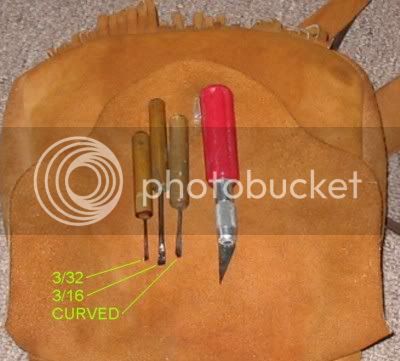Brushbuster: Doc's got it right. The only difference I use is after filing the "draft" or "draw" and forming the inlay so that it rests fully on the stock where it is going to live, I attach it with a small dot of Cynoacrylate Gel ::
Just funnin with ye! Super Glue Gel.
I'm sure Doc's double stick works well too. The important thing to remember is the inlay must not move at all, in any direction while your cutting in the edge.
I'm sure you know what draft or draw is, but for those who don't, it means you file the edges inward towards the bottom of the insert. The angle isn't real critical except it should be noticable. I use something around 5 to 10 degrees.
After securing the inlay to the stock, use the Exacto knife (or equal) with the really sharp point to cut completly around the edge of the inlay. Don't try to do this in one pass and hold the knife at the same angle as the draft so it is forming a tapered cut in the wood which is larger at the surface than it is at the bottom.
When I say "cut" I am really saying stab. Don't try to actually cut along the edge. If you do, the knife point will try to go slicing wood in all directions except the one you want it to.
I usually go around the inlay at least three times to make sure I have a cut which is continious and about as deep as the inlay is thick.
Unlike Doc, I don't bother with a pencil. IMO It is much too course of a line to do much good other than allowing you to easily see where the inlay is going to go.
Because I use super glue, when I'm happy with the cuts I've made, I then give the inlay a light tap straight down on it with a hammer. This usually breaks it loose. If you use Doc's method, you won't have to whack it.
Yup, I, like Doc use really tiny chisles and cut down at about a 30-45 degree angle from the inside of the inlay area towards the incised edge cuts. Take very little cuts. Your just trying to chip in a good safe edge.
I may say others use the exacto knife to do this little task.
While that works well for them, I don't want to risk the point slipping and cutting outside the inlay.
The chisels I use I made from a piece of music wire and a length of wooden dowel.
They look like this:
After chiseling in the edge cuts, I then remove the wood in the middle to a depth which is the same as the inlay is thick.
At this point, I reinstall the inlay. If I did things right, it won't fit down in the pocket very well because of the draft or taper. You can either very gently file off the inlays taper or do as I do, and recut the edge with the Exacto except hold it almost straight up and down to the face of the inlay. About once around it, remove the inlay and the hairlike cuttings this cut produced and then tap the inlay into the pocket.
If it is standing proud of the wood, use a file to file it flush. If it is slightly too deep (almost never happens if your careful about depth when you remove the center area of the cut), you can sand the wood flush with the inlay.
I have been known to use Epoxy under the inlay to hold it in place, but I really can't recommend this.
A much better (+PC) way is to nail it in. Nails have worked well for over 200 years, Epoxy for ???
There are little nails or brads available from some Suppliers but a good Plated Brass straight pin is carried by some Cloth Stores. Drill the smallest holes you can, cut off the pin and tap it in and file the head flush with the inlay.

 :redface:
:redface:




